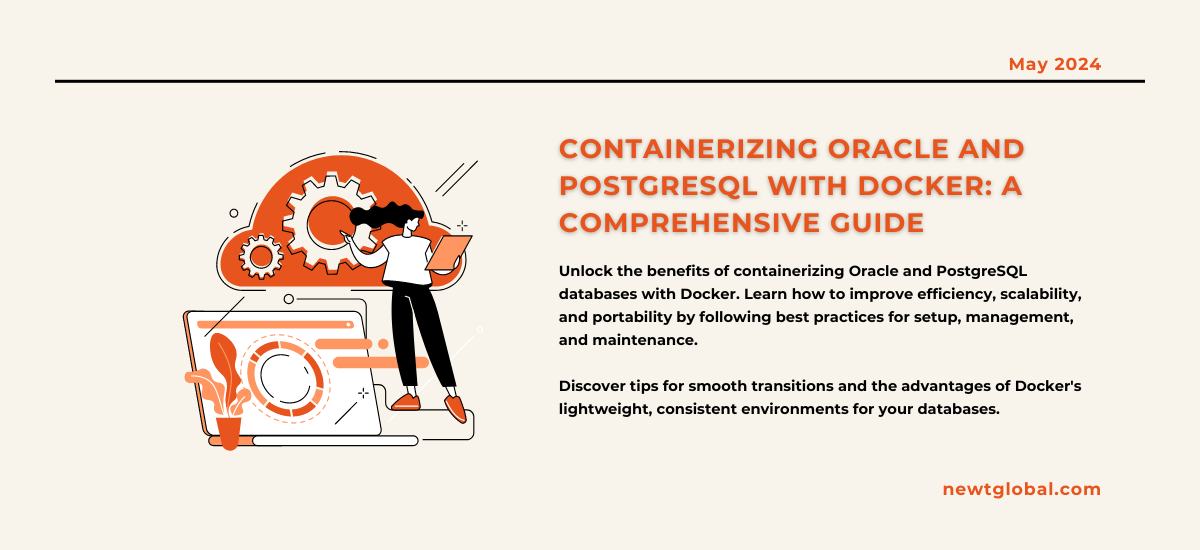
In the fast-changing world of making software, containerization is a big deal. It’s a new and cool way to do things that’s way better than the old-fashioned way of virtualization. One popular use of containerization is putting databases into containers. This is great because it makes them more flexible, portable, and efficient.
Docker is the big name in containerization. With Docker, you can put important databases like Oracle and PostgreSQL into containers. This makes managing databases way smoother and more efficient than before. Let’s explore how to do this with Oracle and PostgreSQL.
Containerization
Think of containerization like packing up software neatly into its own little box, with everything it needs to run smoothly inside. Docker is like the magic that makes this happen. It helps developers and database folks bundle up their applications and all the stuff they need into these handy containers. This makes it a lot simpler to develop and deploy software.
Benefits of Containerized Databases
There are some big advantages to putting databases in containers:
-
- Isolation: Each container runs independently, so you don’t have to worry about them getting in each other’s way.
-
- Portability: You can move your databases around easily, thanks to Docker.
-
- Scalability: It’s easy to adjust the size of your databases to match how much they’re being used.
-
- Consistency: Your testing and production environments will match up better, so there are fewer surprises.
-
- Efficiency: Containers are lightweight and run faster than traditional ways of setting up databases.
Oracle Container
Here’s how to get your Oracle database into a Docker container:
-
- Prep: Make sure Docker is up and running on your computer.
-
- Get Oracle’s Docker Image: Oracle shares its Docker images. Grab them from its GitHub page to start.
-
- Make the Docker Image: In the folder with the Dockerfile for your Oracle version, use Docker commands to create the image.
-
- Start Your Oracle Container: With the image ready, launch the container and set it up with the right settings like port numbers and where to save data.
-
- Connect to Oracle: Once the container is running, use Oracle’s tools to connect to your database.
PostgreSQL Container
For PostgreSQL, the process is smooth and straightforward, thanks to the official images available on Docker Hub:
-
- Get the PostgreSQL Image: Tell Docker to pull the official PostgreSQL image from Docker Hub.
-
- Create Your PostgreSQL Container: With a Docker command, bring your PostgreSQL container to life, setting it up with the right environment for your database.
-
- Keep Your Data Safe: Link your data to Docker volumes to make sure it stays safe even if the container goes away.
-
- Talk to PostgreSQL: Open up and connect to your PostgreSQL database with psql or another compatible tool.
Best Practices
As you dive into using containers for your databases, remember these smart moves:
-
- Keep Data Safe: Make sure your data outlives the container by using volumes.
-
- Stay Secure: Use Docker’s security features to protect your databases.
-
- Manage Resources: Set limits so one container doesn’t hog all your computer’s resources.
-
- Monitor and Log: Keep an eye on how your containers are doing and log what’s happening for easy troubleshooting.
Sometimes you might run into problems, like looking through logs or checking network settings. But don’t worry! There are plenty of resources, like Docker’s documentation and community forums, to help you out.
The Endgame
Putting databases into containers with Docker brings lots of benefits, like being able to move them around easily and making sure they run smoothly. By following the steps for Oracle and PostgreSQL, you’ll be ready to take on your own containerization projects with confidence. Ready to get started? Dive into the guide and become a master of containerized databases with Docker!
Newt Global DMAP is a world-class product enabling mass migration of Oracle Db to cloud-native PostgreSQL faster, better, and cheaper.
Dive deeper into what makes Newt Global DMAP a game-changer in the realm of database migration. Visit us at newtglobal.com for more information on how we can help you achieve seamless, speedy, and secure database transitions. Have questions? Need guidance on your next steps? Our team of experts is here to provide you with the support and insights you need to make informed decisions. Email us at marketing@newtglobalcorp.com, and let’s discuss how we can tailor our solutions to meet your unique requirements.
